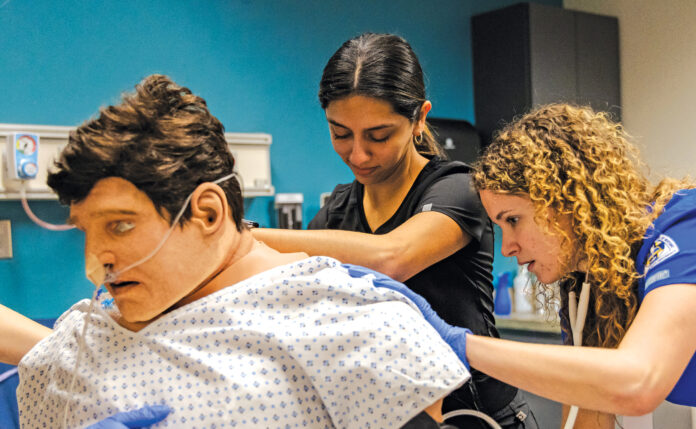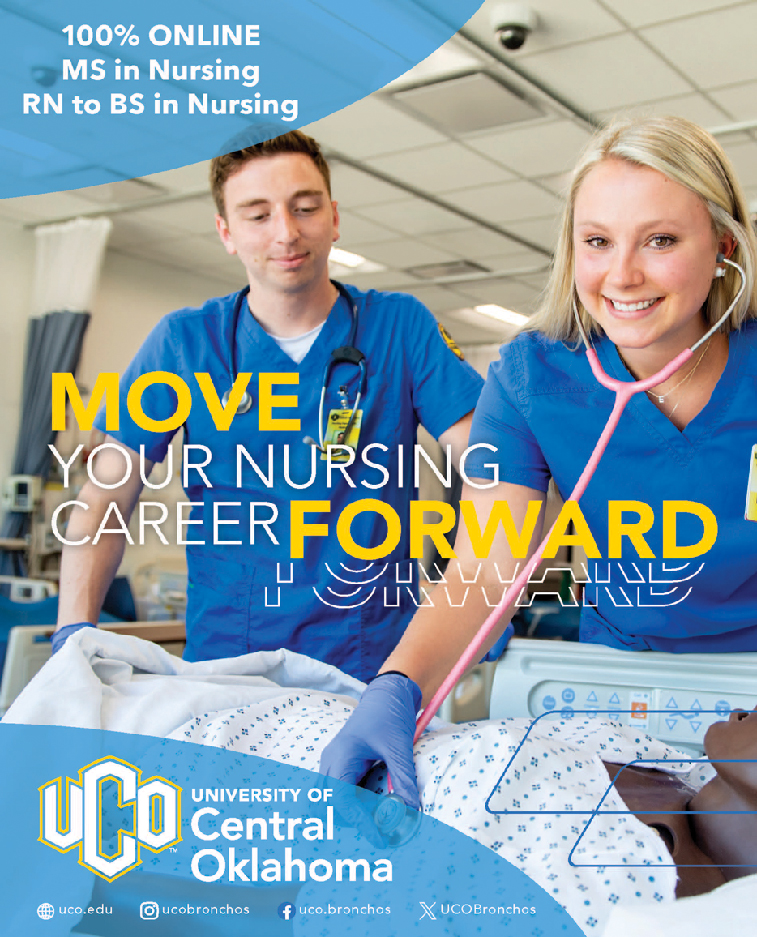
story by
Van Mitchell, Staff Writer
Nursing shortages continue to affect every state, especially in the southwestern United States, where schools like Oklahoma City University’s Kramer School of Nursing have taken innovative steps to help stem that shortage gap.
According to the U.S Bureau of Labor Statistics, Oklahoma ranks 46th in the U.S. for nurses per capita with just 7.5 nurses per 1,000 residents. 2022 statistics indicate there were 30,320 RNs statewide. In comparison, there are 9.22 nurses per 1,000 population in the U.S. to respond to the growing needs of the aging population.
“Oklahoma is ranked 46th in nurses per capita, so we’re on the bottom end of having qualified licensed nurses to serve the population,” Casey Cassidy, Ph.D., RN, CHSE, Associate Dean & Associate Professor at OCU’s Kramer School of Nursing (KSN) said. “We rank below the national average in a lot of areas of our health outcomes as well.”
“A lot of it right now, sadly to say, it’s left over from the pandemic,” she said. “A lot of nurse’s report that they’ve had increased workload due to the pandemic, and that causes high turnover rates. It’s projected that about 20% of licensed nurses will leave the workforce within the next five years. Cited reasons for leaving the workforce include retirements, but also younger nurses leaving due to insufficient staffing and burnout. Additionally, the AACN states the demand for registered nurses is continuing to grow due to emphasis on preventative care, the baby-boomer population living longer, and increased rates of chronic conditions.”
“There’s a lack of nurse educators across the nation, and it’s hard to find qualified faculty, and so that narrows the pipeline,” she said. “I think you’re seeing, because of those two reasons, the shortage persisting.”
Cassidy said OCU has launched several degree programs, trying to attract more students to the nursing profession.
“In 2024, we started our 12-month accelerated Bachelor of Science in Nursing (BSN) program so students with a previous degree (associate’s or a bachelor’s) can, if they’re qualified, start the program, and graduate within a year, and be ready to sit for licensure,” she said.
Due to the intensity of the accelerated BSN, it is recommended that students do not seek employment for the duration of enrollment in the program.
Students will need to commit an average of 32 hours per week to class, and lab/clinical/simulation time. Students should also account for additional study time outside of class and lab/clinical/simulation.
Cassidy said OCU is committed to also preparing nurse educators.
“In 2024 we started our Doctor of Nursing Practice (DNP) nursing education option, so nurses can come and learn those skills to be educators and build on a previous master’s degree that they already have,” she said.
The Nurse Educator track admits nurses who hold master’s degrees in nursing. The track is focused on further development of professional nurse educators to guide and monitor the preparation of diverse learners to enter the profession.
Program tracks range from 30-32 credit hours, post-master’s, and include practicum hours centering on adding depth to the nurse’s area of practice. The DNP empowers the advanced practice nurse to lead innovative application of evidence into practice to address system-level issues, improve health outcomes, and/or strengthen health care systems.
Cassidy said KSN has seen an increase in enrollment from the two new degree programs.
“We did see an increase in 2024, and we’re hoping to carry that momentum forward in 2025,” she said. “We want to prepare high quality RNs for the workforce.”
Cassidy said OCU continues to look at ways to prepare the next generation of nurses.
“I think that our workforce and higher education is constantly changing, and in order to meet the demands of both sectors, it is important to stay innovative,” she said. “Whether that’s looking at how degree plans are created, looking at what the student population is saying what they want, but still maintaining high quality standards of our curriculum.”
Cassidy said higher education is sometimes not attainable because of financial reasons.
“Another thing that we’ve done recently is we’ve lowered the program cost, and Dean Gina Crawford has secured additional scholarships,” Cassidy said. “And that’s really to take the burden off our students.”
Cassidy added, “Here at Kramer, we have focused on addressing potential barriers for students in a holistic manner. This past year, we helped students be successful and enter the workforce faster by implementing innovative curriculum design, student support services, lowering the cost of the program, and providing additional financial support through transfer scholarships and/or donor scholarship.”












